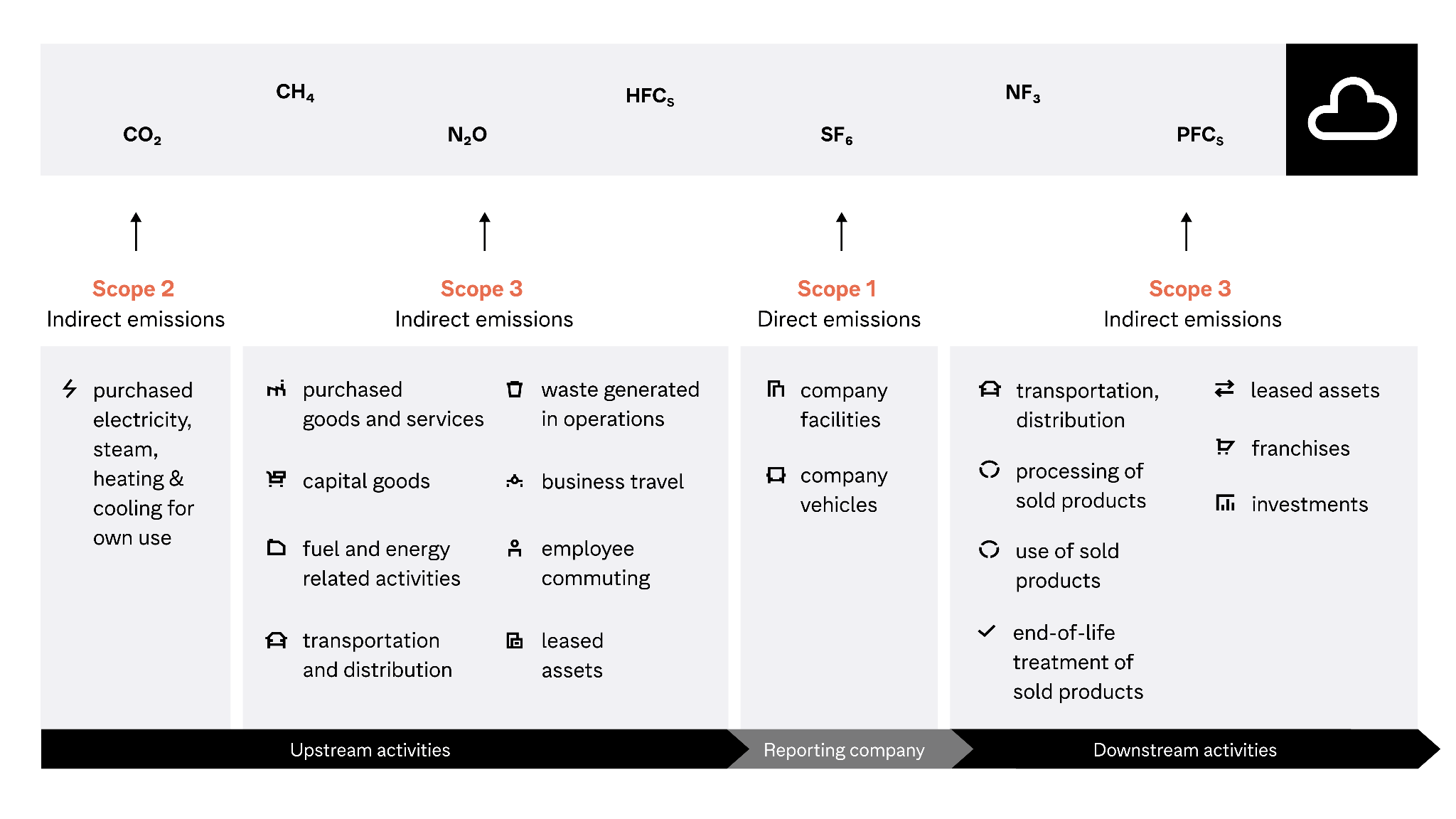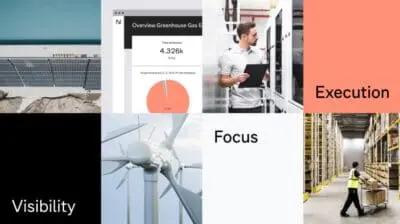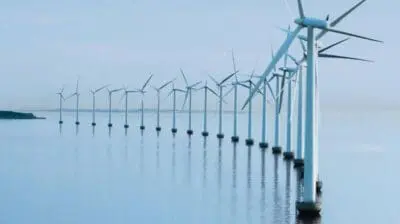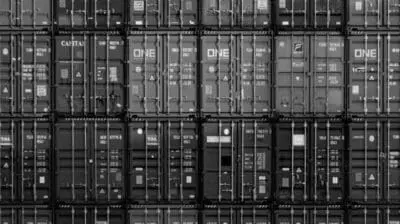Upstream and downstream emissions, explained

The Greenhouse Gas Protocol divides scope 3 emissions into upstream and downstream sources.
If your business is like most others, scope 3 is responsible for the majority of your carbon footprint.
Scope 3 – also called value chain emissions – accounts for around 90% of the average business’s climate impact.
To comprehensively report and reduce your business’s emissions, you need to know your full scope 3 emissions – and to achieve that, you will need to calculate your upstream and downstream emissions sources.
What are scope 3 emissions?
Scope 3 emissions are all the indirect emissions that occur in the value chain of a company. These emissions are a consequence of the company’s business activities but occur from sources the company does not own or control.
According to the CDP, scope 3 emissions account for around 90% of an average company’s emissions.
Scope 3 emissions, explained
What scope 3 emissions are, why they’re important, and how your business can effectively manage them.
Go to the article
What are upstream and downstream emissions?
The Greenhouse Gas Protocol – the most widely-used framework for calculating business carbon emissions – divides scope 3 emissions into upstream and downstream sources.
Upstream emissions come from the production of your business’s products or services, while downstream emissions come from their use and disposal.
The infographic below displays a business’s upstream and downstream activities, as well as the 15 categories of scope 3 emissions defined by the Greenhouse Gas Protocol:

Upstream emissions scope 3 categories
Upstream emissions occur during the production of goods or services that a business purchases or uses.
For example: if your retail business uses plastic to produce its products, the emissions resulting from the production and transportation of that plastic would be upstream emissions.
The table below contains a simplified version of the eight upstream emissions categories defined by the Greenhouse Gas Protocol:
| Category | Description |
|---|---|
| Purchased goods and services | Extraction, production, and transportation of goods and services purchased or acquired by the company |
| Capital goods | Extraction, production, and transportation of capital goods purchased or acquired by the company |
| Fuel- and energy-related activities | Extraction, production, and transportation of fuels and energy purchased or acquired by the company which are not already accounted for in scope 1 or scope 2 |
| Upstream transportation and distribution | Transportation and distribution of products purchased by the company, as well as other transportation and distribution services like inbound logistics, outbound logistics, and transpiration between company facilities |
| Waste generated in operations | Disposal and treatment of waste generated in the company’s operations, in facilities not owned or controlled by the company |
| Business travel | Transportation of employees for business-related activities in vehicles not owned or operated by the company |
| Employee commuting | Transportation of employees between their homes and their worksites in vehicles not owned or operated by the company |
| Upstream leased assets | Operation of assets leased by the company and not included in scope 1 and scope 2 |
Refer to the Greenhouse Gas Protocol’s Technical Guidance for Calculating Scope 3 Emissions for a more detailed breakdown of the categories.
How Flying Tiger calculated and reduced its scope 3 emissions
The global retailer used Normative to discover an unexpected emissions hotspot in its upstream activities.
Go to the customer story
Downstream emissions scope 3 categories
Downstream emissions result from the use or disposal of a business’s products or services.
For example: if your company manufactures machinery, the emissions that result from the use of that machinery would be considered downstream emissions.
| Category | Description |
|---|---|
| Downstream transportation and distribution | Transportation and distribution of products sold by the company between the company’s operations and the end consumer |
| Processing of sold products | Processing of intermediate products sold by downstream companies |
| Use of sold products | End use of goods and services sold by the company |
| End-of-life treatment of sold products | Waste disposal and treatment of products sold by the company, at the end of the products’ lives |
| Downstreamleased assets | Operation of assets owned by the company and leased to other entities |
| Franchises | Operation of franchises in the reporting year, not included in scope 1 and scope2 |
| Investments | Operation of investments, including equity and debt investments and project finance |
Refer to the Greenhouse Gas Protocol’s Technical Guidance for Calculating Scope 3 Emissions for a more detailed breakdown of the categories.
Why classify emissions in this way?
By dividing its scope 3 carbon footprint into upstream and downstream sources, a business can better focus its emissions calculation and reduction efforts.
A company’s business model will provide clues to its likely sources of emissions hotspots.
For instance, retailers will often have large upstream emissions due to the production of the goods they sell. While businesses in financial services, on the other hand, often find their carbon footprint concentrated in downstream sources due to their investments.
How to manage your upstream and downstream emissions
To manage your upstream and downstream emissions, you first need to measure them. But calculating these emissions manually is a time-consuming process, and one that’s prone to human error.
Instead of manual calculations, businesses can use software-based carbon accounting to calculate, report, and reduce their upstream and downstream emissions.
Carbon accounting, like financial accounting, quantifies the impact of an organization’s business activities – though instead of financial impact, it measures climate impact.
By using a comprehensive, automated, and science-backed carbon accounting provider, you empower your business to efficiently calculate its full carbon footprint, including the upstream and downstream emissions in your business’s value chain.
You can then use these calculations to identify hotspots, implement reduction measures, and track your progress.
Calculate upstream and downstream emissions with industry-leading accuracy
Normative’s automated, Greenhouse Gas Protocol-based emissions calculations empower businesses to calculate, report, and reduce their carbon footprint.
FAQs
Greenhouse gas emissions are classified into three scopes: scope 1, scope 2, and scope 3. These scopes are determined by where the emissions originate from. The terminology of scope 1, 2, and 3 was introduced in the Greenhouse Gas Protocol (GHG Protocol), which sets the standards for measuring GHG emissions all around the world.
Because scope 3 contains such a broad range of emissions sources, the Greenhouse Gas Protocol further breaks scope 3 down into 15 sub-categories. These categories are grouped into upstream or downstream sources. You can find these categories listed in the tables above.
Upstream emissions occur during the production of goods or services that a business purchases or uses.
Downstream emissions occur after the production of a company’s products or services, during use or disposal.











